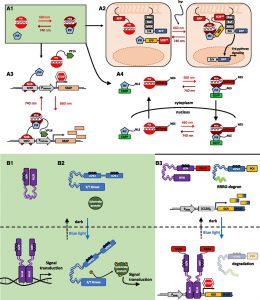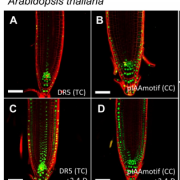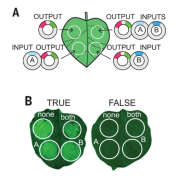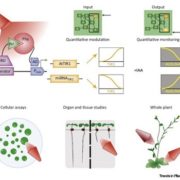Review: Synthetic switches and regulatory circuits in plants (Plant Physiol)
 Switches and circuits are key parts of a synthetic biologist’s toolbox. Andres et al. provide historical background and core ideas as well as current understanding of these devices. Switches are defined as components that detect an input signal and transform it into an output signal. Inputs can be chemicals (e.g., tetracycline or dexamethasone) or, light, which is the input signal used in the optogenetics systems. These switches are most useful when very tightly controlled, so that a predictable outcome can be obtained, and also when they don’t alter or interfere with other cellular processes; this latter property is referred to as orthogonality. Many switches have transcriptional responses as their output, but they can also function post-transcriptionally, for example through the production of a gene-silencing RNAi. Genetic circuits are assembled from multiple switches. Circuits can lead to oscillatory responses, bistable states, or form Boolean logic gates that interpret multiple inputs to produce defined outputs, using AND, OR, NAND, and NOR (examples of these are included in the review). The multicellularity and mult-compartmentality of plants provides both opportunities and challenges for implementing these tools beyond those of the simple organisms is which they have been developed. (Summary by Mary Williams) Plant Physiol. 10.1104/pp.18.01362
Switches and circuits are key parts of a synthetic biologist’s toolbox. Andres et al. provide historical background and core ideas as well as current understanding of these devices. Switches are defined as components that detect an input signal and transform it into an output signal. Inputs can be chemicals (e.g., tetracycline or dexamethasone) or, light, which is the input signal used in the optogenetics systems. These switches are most useful when very tightly controlled, so that a predictable outcome can be obtained, and also when they don’t alter or interfere with other cellular processes; this latter property is referred to as orthogonality. Many switches have transcriptional responses as their output, but they can also function post-transcriptionally, for example through the production of a gene-silencing RNAi. Genetic circuits are assembled from multiple switches. Circuits can lead to oscillatory responses, bistable states, or form Boolean logic gates that interpret multiple inputs to produce defined outputs, using AND, OR, NAND, and NOR (examples of these are included in the review). The multicellularity and mult-compartmentality of plants provides both opportunities and challenges for implementing these tools beyond those of the simple organisms is which they have been developed. (Summary by Mary Williams) Plant Physiol. 10.1104/pp.18.01362









